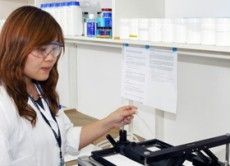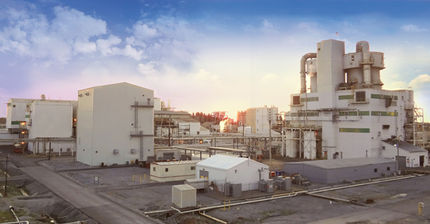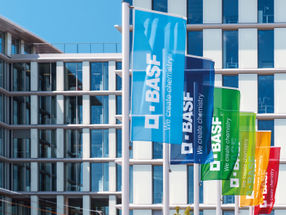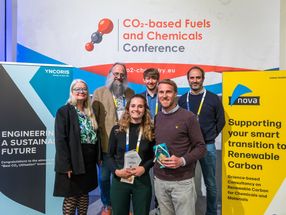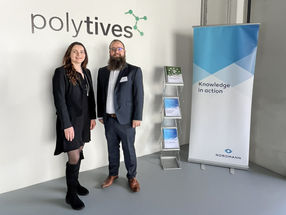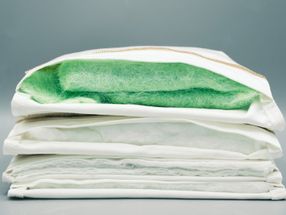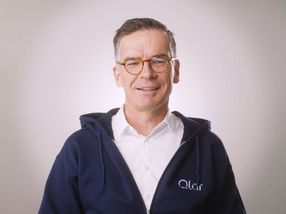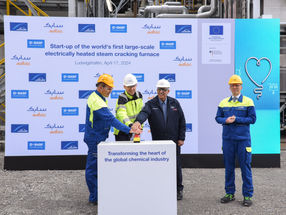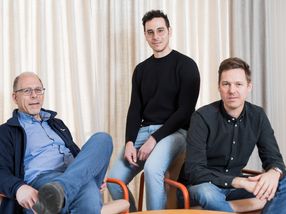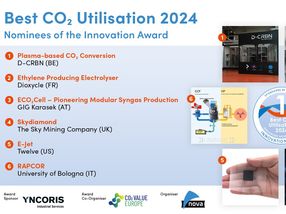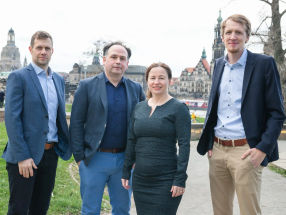WACKER’S 2017 Forecast is again for Sales Growth and High Net Cash Flow
As already reported, Wacker Chemie AG met its sales target and exceeded its earnings expectations in 2016. On presenting its annual report, the Munich-based chemical company announced that Group sales came in at €5.40 billion, up 2 percent year over year (2015: €5.30 billion). The rise was mainly due to higher volumes. EBITDA – earnings before interest, taxes, depreciation and amortization – totaled €1,101.4 million in 2016 (2015: €1,048.8 million). This corresponds to an EBITDA margin of 20.4 percent (2015: 19.8 percent).
Although special income from advance payments retained and damages received from solar customers was much lower than in 2015, EBITDA was 5 percent above the prior-year value. Special income totaled €20.3 million in full-year 2016 (2015: €137.6 million). Adjusted for this effect, EBITDA reached €1,081.1 million (2015: €911.2 million), a rise of around 19 percent. The Group’s EBIT (earnings before interest and taxes) came in at €366.2 million in 2016 (2015: €473.4 million), a year-over-year decline of 23 percent. A key factor here was that depreciation rose significantly. It amounted to €735.2 million in 2016 (2015: €575.4 million). On the bottom line, WACKER ended 2016 with Group net income of €189.3 million (2015: €241.8 million). That was around 22 percent less than the year before.
In 2017, WACKER intends to continue its good performance, despite expectations of higher raw-material prices. For the full year, WACKER aims to lift its sales by a mid-single-digit percentage. Group EBITDA is projected at last year’s level – when adjusted on a comparable basis to exclude special income from damages received and from terminated contractual and delivery relationships with solar customers. WACKER anticipates a high cash inflow from operating activities again in 2017. At about €400 million, net cash flow should be at a similar level to the year before. Group net income is also projected to reach the year-earlier level.
During the first two months of the current year, WACKER’s business developed positively. In chemicals, and at Siltronic and WACKER POLYSILICON, sales for the first two months were clearly above the comparable values of last year. Overall, WACKER expects to generate sales of some €1.4 billion in the first quarter of 2017 (Q1 2016: €1.31 billion). In addition to volume growth, WACKER is achieving better prices than a year earlier, especially for semiconductor wafers. As a result, the Group expects EBITDA to grow significantly in Q1 2017.
“WACKER is in very good shape,” said CEO Rudolf Staudigl in Munich on Tuesday. “We expect volumes to rise at every division. In the industry sectors relevant to our business, the trend will be broadly positive in 2017. That is why we are confident of increasing sales by a slightly higher percentage than last year. We are, however, facing headwind from raw-material prices. At present, they are rising significantly and this could impact earnings. If current market conditions remain unchanged during the year, we definitely see additional upward potential for EBITDA – over and above our present expectations.”
Capital Expenditures
In 2016, the Group’s capital expenditures amounted to €427.6 million (2015: €834.0 million). They dropped by about half versus the year before, as expected.
One of the priorities of investing activities last year remained the completion of the new polysilicon site at Charleston, Tennessee (USA). Some €100 million – or about a quarter of total capital spending in 2016 – went toward this project. WACKER finished commissioning the production facilities there on schedule in the third quarter of 2016.
A further investment priority in 2016 was expanding capacities for manufacturing downstream products. For example, WACKER increased production capacity for cyclodextrins by 30 percent at its site in Eddyville, Iowa (USA). At its Burghausen site, it expanded production of functional silicone fluids in several stages. Capital spending for this amounted to some €25 million. Siltronic’s Freiberg site invested in new pulling facilities for manufacturing silicon monocrystals.
In 2016, WACKER began additional investment projects. These include new facilities for silicone products at sites in Jincheon (South Korea) and Jandira (Brazil). In Burghausen, WACKER is building a new reactor for polymeric dispersions and is expanding a plant for hydrophobic specialty grades of silica.
Employees
Sales growth at the chemical divisions and the start-up of the new site in Charleston, Tennessee, expanded the Group’s workforce. The number of employees rose by around 230 in 2016. The Group had 17,205 employees worldwide as of December 31, 2016 (Dec. 31, 2015: 16,972). Its German sites had 12,138 employees at the reporting date (2015: 12,251) and its international sites 5,067 (2015: 4,721).
Net Cash Flow, Net Financial Debt and Equity Ratio
As projected, the Group’s net cash flow was clearly positive, increasing many times over versus the year before. It came in at €400.6 million (2015: €22.5 million). This strong rise was mainly due to the marked decline in capital expenditures. The Group’s net financial debt amounted to €992.5 million as of December 31, 2016 (Dec. 31, 2015: €1,074.0 million). It was slightly below the year-earlier level, as planned. WACKER’s total assets amounted to €7.46 billion as of December 31, 2016, rising by about €200 million compared with the year before (Dec. 31, 2015: €7.26 billion). The key factors supporting this increase of almost 3 percent were higher trade receivables and higher inventories. At the reporting date, Group equity amounted to around €2.59 billion (Dec. 31, 2015: €2.80 billion). The corresponding equity ratio was 34.8 percent (Dec. 31, 2015: 38.5 percent). The decline was basically caused by an adjustment to pension provisions recognized in other comprehensive income, as the result of a change in the discount rate. Pension provisions amounted to €2.11 billion at the reporting date (Dec. 31, 2015: €1.61 billion). Compared with their September 30 peak of last year (€2.57 billion), pension provisions were down by about €460 million by the end of the year.
Business Divisions
In 2016, sales at WACKER SILICONES topped the two-billion-euro mark for the first time, rising to €2.00 billion (2015: €1.94 billion). The main reason for this 3-percent increase was volume growth amid somewhat lower prices. EBITDA outpaced sales growth, climbing 31 percent to €361.2 million (2015: €276.2 million). The rise was fueled by volume growth, good plant utilization and high levels of cost efficiency.
Sales at WACKER POLYMERS grew slightly in 2016, up 1 percent to around €1.20 billion (2015: €1.19 billion). Growth was mainly driven by higher volumes for dispersions and dispersible polymer powders. Lower prices had the opposite effect. EBITDA amounted to €261.0 million, rising by around 17 percent (2015: €222.2 million). This reflected the impact of much higher volumes, good plant capacity utilization and very high levels of cost efficiency.
The sales trend was positive at WACKER BIOSOLUTIONS, too. Sales rose by around 5 percent in 2016 to €206.4 million (2015: €197.1 million). It was essentially higher volumes that spurred the increase, while lower prices had the opposite effect. EBITDA increased by 15 percent to €37.0 million (2015: €32.2 million), mainly due to volume growth and high plant utilization.
WACKER POLYSILICON lifted its sales slightly in 2016. They climbed 3 percent to around €1.10 billion (2015: €1.06 billion). The rise was due to substantial volume growth, despite the fact that average solar-silicon prices were lower. At over 66,000 metric tons, the division sold more polysilicon last year than the year before (2015: 56,000 metric tons). EBITDA amounted to €285.9 million, 29 percent below the previous year’s level (2015: €402.4 million). The decline was basically caused by lower average prices, by start-up costs at the new production site at Charleston, Tennessee (USA), and by a substantial reduction in special income from advance payments retained and damages received from customers. In 2016, special income amounted to €20.3 million (2015: €137.6 million).
At Siltronic, sales in 2016 were roughly on a par with the previous year, coming in at €933.4 million (2015: €931.3 million). Volume gains and favorable exchange-rate effects were countered by lower prices. EBITDA improved by about 18 percent year over year, climbing to €145.9 million (2015: €124.0 million). Positive factors influencing EBITDA included additional cost-reduction measures, high rates of production-capacity utilization and lower currency-hedging expenses.
Proposal on Appropriation of Profits
In 2016, Wacker Chemie AG posted a retained profit of €1,243.8 million under German Commercial Code accounting rules. The Executive and Supervisory Boards will propose a dividend of €2.00 per share (2015: €2.00) at the Annual Shareholders’ Meeting. Based on the number of shares entitled to dividends as of December 31, 2016, the cash dividend corresponds to a payout of €99.4 million. Calculated in relation to WACKER’s average share price in 2016, the dividend yield is 2.6 percent.
Outlook
Estimates by economic experts indicate that the world economy is on track for moderate growth. But the projections involve major uncertainties.
WACKER’s chemical business offers good prospects for further growth in 2017. Sales are projected to continue rising at all three chemical divisions. At WACKER SILICONES and WACKER POLYMERS, sales are expected to grow by a mid-single-digit percentage, with all business units contributing. At WACKER BIOSOLUTIONS, the sales forecast is for a low-single-digit percentage increase, chiefly driven by products for the pharmaceutical and agrochemical industries.
EBITDA at WACKER SILICONES should rise slightly year over year, amid higher raw-material prices in some cases. At WACKER POLYMERS, the EBITDA projection is for a substantial year-over-year decline due to expectations of much higher raw-material prices – with the projected EBITDA margin exceeding the 16 percent targeted for WACKER’s chemical divisions. At WACKER BIOSOLUTIONS, integration costs for the new site in Spain will impact 2017’s EBITDA, which will be significantly lower than last year.
In its polysilicon business, WACKER expects additional volume growth in 2017. The Group’s assumption is that the photovoltaic market will continue on its growth trajectory. Given the fact that average solar-silicon prices are likely to be lower than a year earlier, WACKER POLYSILICON expects sales to only match last year’s level despite volume growth. The division’s EBITDA should be somewhat higher than last year – when adjusted on a comparable basis to exclude special income from advance payments retained and damages received.
In its semiconductor business, WACKER is projecting a high-single-digit percentage increase in sales. Siltronic expects sales to reach at least €1 billion in the current year, mainly spurred by volume gains and higher sales prices. In 200 mm and 300 mm wafer business, the company anticipates high capacity utilization. EBITDA is likely to climb substantially year over year. Siltronic forecasts an EBITDA margin of at least 20 percent, potentially even significantly higher.
Overall, WACKER expects Group sales to rise by a mid-single-digit percentage in 2017. EBITDA – adjusted on a comparable basis to exclude special income – should be on a par with last year. If current market conditions continue during the year, there will be additional opportunities for the EBITDA trend. The Group’s EBITDA margin is projected to be slightly below the year-earlier level due to generally lower prices for its own products and rising raw-material prices. At around €450 million, capital expenditures will edge up slightly versus last year. Depreciation will be slightly below last year’s level, at around €720 million. Group net income is projected to be at the year-earlier level. Net cash flow should be clearly positive and at a similar level to last year. Net financial debt will decrease significantly.
